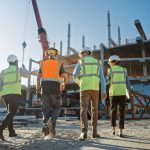Sector - Supply Chain
Housebuilders struggle with ‘E’ in ESG

Housebuilders, banks and investors who gathered to discuss the findings in a new report ESG: Investing in the built environment agreed that capital availability for developments is soon likely to be increasingly linked to ESG (Environmental, Social and Governance) performance. However, housebuilders felt more confident in their efforts to demonstrate performance against social KPIs (the “S” in ESG) than the report claimed.
International law firm Womble Bond Dickinson published the new ESG report in June 2023, in collaboration with the Cambridge University, to illustrate how businesses working in the built environment have incorporated ESG priorities into their investment decision making.
The majority of the sector representatives at the roundtable agreed that an increase in the pace of demands for higher standards in the ‘E’ of ESG was happening. It also became clear that all stakeholders working in the built environment would need to adapt, work together, and educate its workforce and suppliers through a process with moving goal posts.
However, whilst the report referenced the immaturity of the social and governance pillars, the housebuilders, banks, and investors agreed that these were the most currently quantifiable areas where progress had been made in this particular housebuilder sector.
Charlie Reid, partner at Womble Bond Dickinson said: “The report concluded that environmental measurement was one of the more mature pillars in many ESG strategies but discussions at the roundtable flagged the depth of knowledge required to meet ambitious environmental targets and the not insignificant task of keeping up with new environmental policy and technologies. More complex still was how to embed these changing principles across the wider supply chain and whether, if not taken at the right pace, this would be detrimental to SMEs and sole traders (for cost reasons).
“On the other hand, the housebuilders expressed their confidence that, from a governance perspective, they are generally moving in the right direction. Similarly, with their social values, they are confident that they have already made material progress in this space.”
The demand for high ESG performance isn’t just coming from the government and banks, consumers are also showing increasing appetite for properties that score higher in these areas. Nicola Giddens, partner at Womble Bond Dickinson said: “Housebuilders in particular said that ESG has become a “top five issue” for their customers and that quality of life is a big driver behind the decisions that they make. The contributors agreed that this was likely influenced by the energy crisis and extended periods of time in the home environment during lockdown.
“The housebuilders who shared this view also felt that by focusing on the social pillar of ESG, it would give them a “head start” on meeting more ambitious targets in relation to the ‘E’ of their strategy as the ‘E’ and ‘S’ of an ESG strategy are often complimentary. This was because environmental stewardship is inevitably part of social value. The housebuilders who shared this view hope that social value addresses economic resilience and will support greener jobs, both of which are high on the agenda during the current economic challenges.
“Additionally, it was also apparent during the discussion that housebuilders can deliver an ESG strategy whilst simultaneously tackling other external challenges. Implementing an ESG strategy whilst managing inflation, increasing interest rates, higher material costs and labour shortages aren’t mutually exclusive concepts for housebuilders with the scale to address it. It will require greater collaboration from all stakeholders, and forward thinking aimed at long-term investments, but ultimately ESG practices offer potential solutions to the challenges businesses are facing. That being said, it needs to be acknowledged that for sole traders and SMEs with limited resource, it would prove an administrative and cost challenge in the current economic climate.”
Dr Gemma Burgess, from Cambridge Centre for Housing and Planning Research said: “Our research showed the variety of ways housebuilders are approaching their ESG reporting. Without defined standards regulating the ESG playing field many housebuilders are operating independently. We hoped the ESG report would open the conversation on how industry can work more closely together. The roundtable discussion highlighted that funding through all development loans, with a particular focus on Sustainability Linked Loans (SLLs), meant that those operating in the built environment needed to be ambitious when approaching the ‘E’ in ESG strategies to secure funding in the future. This is why all industry players are having to learn and adapt to new ways of operating which is always easier with cross-industry collaboration. We’re delighted the report facilitated the discussion around challenging environmental reporting, but also celebrated housebuilder’s successes, in the absence of clear direction regarding regulation and taxonomy.”
If you would like to read more stories like this, then please click here
Related Articles
More Supply Chain News
- Flagship Ulster University capital build project procurement opportunity now live
9 Oct 25
Submit a tender now.
- Modular frameworks create a monumental opportunity for UK public sector construction
5 Sep 25
Modular Buildings 3, allows public sector organisations to access a verified list of modular construction
- New report sets out technology and research needed to reach net zero
3 Sep 25
A new government-backed report has outlined the research and technology priorities needed for the UK






